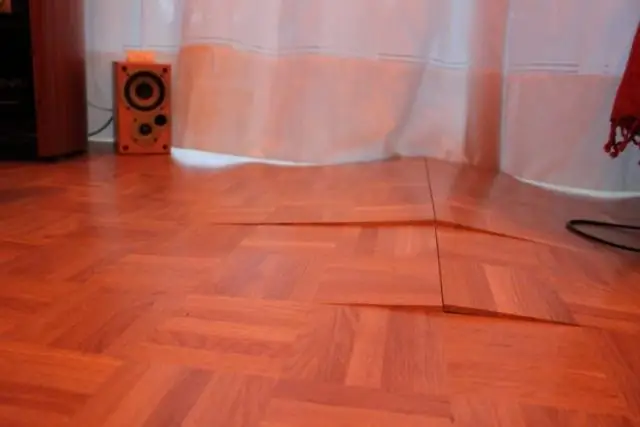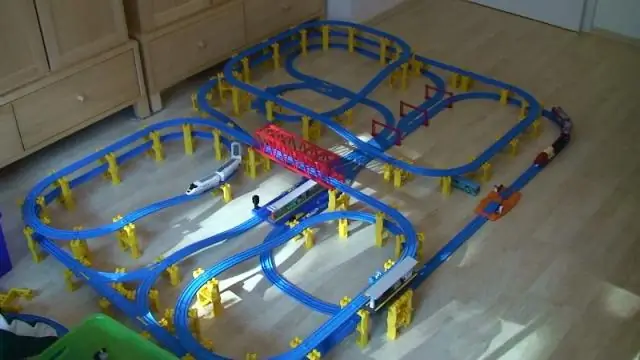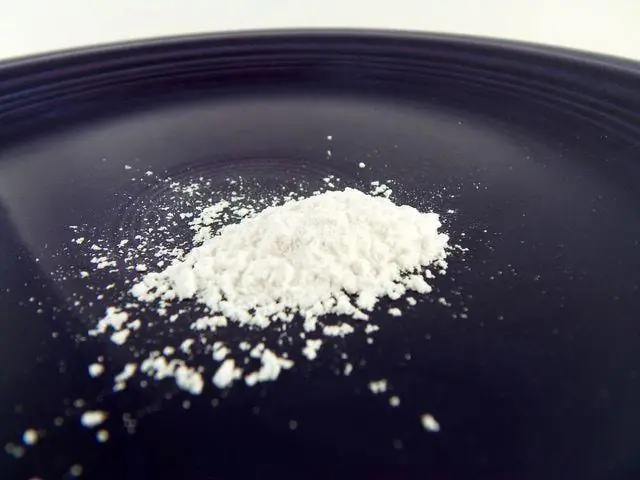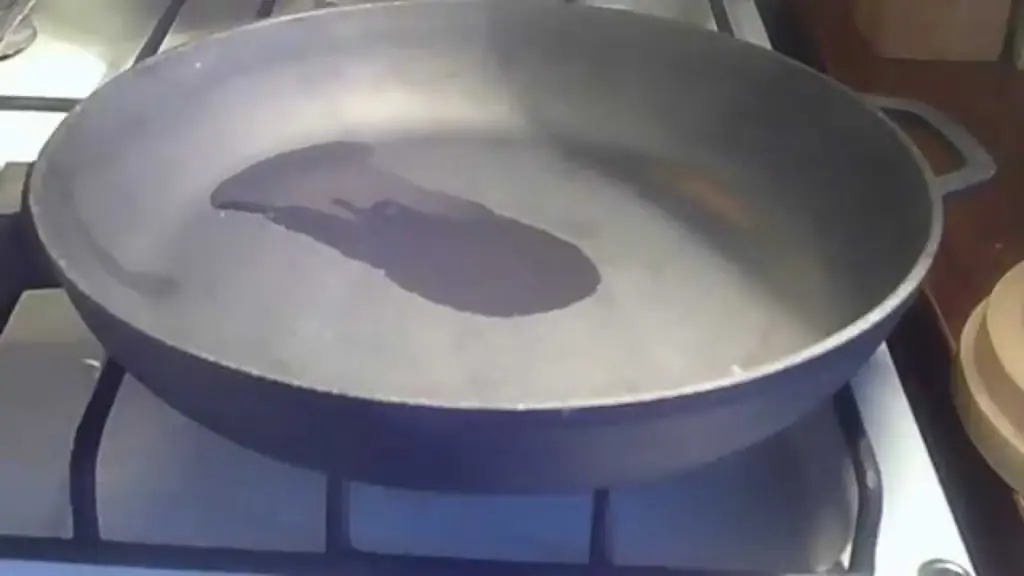
Table of contents:
- Laminate creaks: the causes of the problem and how to fix them
- What is laminate
- Why laminate flooring creaks when walking: the main reasons
- Elimination of squeak without parsing the coverage in the apartment
- How to get rid of a squeak when parsing a floor covering
- What to do to prevent the laminate from creaking: prevention, installation tips
- Author Bailey Albertson [email protected].
- Public 2023-12-17 12:53.
- Last modified 2025-06-01 07:32.
Laminate creaks: the causes of the problem and how to fix them

Laminate is one of the most practical and aesthetic floor coverings. But if mistakes are made during its installation or already during operation, it starts to creak. Eliminating the cause of such a malfunction will help to solve the problem. This can be done with or without parsing the coverage.
Content
- 1 What is laminate
- 2 Why laminate flooring creaks when walking: the main reasons
-
3 Elimination of squeak without parsing the coverage in the apartment
- 3.1 How to fix squeaks with wax
- 3.2 How to remove a creak due to base defects using self-tapping screws and PVA glue
-
4 How to get rid of the squeak when parsing the flooring
- 4.1 How to correct defects in the base
- 4.2 Disassembling the laminate to correct installation errors
- 4.3 How to eliminate noise from debris under the laminate
- 4.4 Laminate: what to do if it starts to creak - video
-
5 What to do to prevent the laminate from squeaking: prevention, installation tips
5.1 How to choose a quality laminate - video
What is laminate
The floor covering in the form of a multi-layer panel based on chipboard or fiberboard is a laminate. All its parts are impregnated with melamine resins and pressed under high temperature and pressure.
- The outer protective layer is a laminating film based on acrylic or melamine resins. Its task is to protect the floor from dirt, sunburn, water, and abrasion.
- The decorative layer is paper imitating the texture of valuable wood species, natural stone and other materials.
- The basis is a fiberboard or chipboard plate, which guarantees the strength of the entire structure. Sometimes the base and the decorative layer have between them a paper layer impregnated with synthetic resins.
- The bottom layer is a waterproof melamine coating that ensures the rigidity of the laminate and prevents deformation.
Despite the many layers, the board thickness ranges from 6 to 12 mm. The wear resistance of the material depends on the percentage of melamine resins and the thickness of the protective layer.

The special multi-layer construction of the laminate makes it an extremely practical coating
Why laminate flooring creaks when walking: the main reasons
Having installed laminate floors, you think that now you have received an excellent coating that will last you a long time and flawlessly. And in most cases this is how it happens, but sometimes the floors begin to annoy with an unpleasant creak when walking. This happens for a variety of reasons.
- Uneven base. With poor preparation of the base, the laminate creaks in some places, and always in one location, where the surface has unevenness. The laminate above them flexes when pressed, making a creaking sound. Therefore, when installing laminate flooring, the floors should be leveled to near-perfect condition and checked with a level.
-
Substrate thickness. A thick substrate is usually purchased for the purpose of leveling pits and drops. But often this leads to a worsening of the problem. It is desirable that the thickness of the substrate does not exceed 2-3 mm. Otherwise, the sagging of the laminate over the depressions increases even more, which leads to a squeak.

Laminate underlay in hand A backing that is too thick can cause the laminate to squeak
- Invalid gap between laminate and wall. The gap between the walls and the laminate flooring is mandatory, since it allows the slabs to diverge, taking the most suitable position for it. This relieves stress on the locks, preventing the floor from squeaking. With a small or no gap, the laminate rests against the baseboards and walls, provoking a creak. The larger the dimensions of the room where the laminate is mounted, the larger the gap should be made. In any case, it must be at least 7 mm. You can understand that you are faced with this particular problem by swelling the lamellas near the walls.
- Variable indoor humidity. In some cases, the reason for the squeak is the reaction of the laminate to fluctuations in humidity. When it increases, the coating begins to crunch or creak, and over the entire plane, and not in places. When the previous percentage of humidity returns, the creak stops or decreases significantly.
- Ingress of dust and sand. Installation of laminate is unthinkable without strict adherence to cleanliness. So, it is constantly required to use a vacuum cleaner to remove dust from laminate boards, substrates and bases, since it is they, who, getting into the locks of the coating, can cause creaking when walking. In addition, sand can destroy laminate locks. By the way, the screed can also creak when shedding, so it must be primed. To establish this cause of the squeak, the laminate will have to be completely removed.
- The use of substandard material. The use of a low-quality board during installation can cause the coating to creak, even if all other elements are of good quality and all the rules for laying the floor have been followed. The reason for the squeak is mainly locks that do not correspond in size to the norm. The problem can only be identified after disassembling the laminate and replacing it.
-
The tension in the locking elements. This reason for the creak of the laminate is usually eliminated by itself after a couple of months after installation. This is characteristic of good quality flooring and is due to the process of adjusting the laminate to the surrounding space. With a normal gap between the plates and the walls, the laminate takes an optimal position, and the locking elements stop creaking. If this does not happen, then the coating squeaks for another reason.

Locking lamellas Tension in the interlocking joints of the laminate can cause the coating to squeak.
- There is debris under the laminate. With poor cleaning of the base during installation, there may be construction debris, small stones, sand under the slabs. Immediately after installation, their presence does not manifest itself in any way, but after some time after the start of operation of the coating, the substrate lying on the debris begins to wrinkle. And the small solid fragments located under it provoke floors creaking and can even ruin the laminate panels. To identify this cause, a coverage analysis is also needed.
- Laying laminate on old parquet. Mounting lamellas on a parquet base, where there are rotting and creaking boards, you risk that the laminate itself will deteriorate and make noise during operation. Therefore, the damaged fragments are removed, replacing them with a screed, and the creaking boards are fixed in place with self-tapping screws so that their caps are below the general level of the base.
Elimination of squeak without parsing the coverage in the apartment
In some cases, it is possible to eliminate the squeak without completely or partially dismantling the laminate. This may not always be possible, but it is best to try these methods first.
How to fix a squeak with wax
In order to eliminate local squeak without unnecessary financial costs, you can use a regular candle. This method is used if the coating squeaks due to the locking elements. In this case, the wax will protect them from moisture.
- A paraffin candle is lit and the seams of laminate boards in creaking places are smeared with drops of molten wax.
- Once the wax has hit the right place, it is rubbed with a thin plastic spatula.
If you do not intend to save on quality, you can purchase a special sealant for laminate joints - Aqua Stop, Bostik Clic Protect and others.

Wax from paraffin candles is buried in the seams between laminate boards to eliminate the squeak of the coating
How to remove a creak due to base defects using self-tapping screws and PVA glue
- If the coating creaks along the walls, then you will need to remove the skirting boards and fill the laminate joints in this area with polyurethane foam or fill in with PVA glue.
- With creaks in the middle of the room in a specific place associated with a small unevenness of the base, holes with a diameter of 0.6 mm are made in the slabs, and so that only the lamella is drilled without touching the base. Then PVA glue is pumped into the hole under the drilled area using a 10-20 ml syringe until the hole is filled. Then, you cannot step on this place for two days. After that, the hole is putty. This option is relevant if we are talking about a creak due to a small hole in the base. If the laminate does not stop squeaking, the problem is not with a defect in the substrate and the floor will have to be taken apart.
Another method is screwing in self-tapping screws.
- First, mark the creaking places with chalk.
- With a drill at low speeds, we drill several holes in these places.
- Gently screw into the holes self-tapping screws with a diameter of at least 6 mm with small caps. But their length depends on the thickness of the lamellas.
The key point is that the self-tapping screw must go through all layers of the laminate, reach the base, but not drill it. This method allows the coating not to fall into the hole when stepping on it, creating a support in the form of self-tapping screws in the problem area. After a few days, tighten the screws.

To eliminate the creak of the laminate due to small irregularities in the base, use PVA glue
How to get rid of a squeak when parsing a floor covering
In some cases, it is not possible to get rid of the creaking of the laminate without disassembling it.
How to fix base defects
If the cause of the unpleasant sound is an uneven base, then the coating is disassembled to a creaking place, where they are looking for the depression that caused the problem, and they cover it with a solution or lay it with several sheets of cardboard. If there are several such places, you will have to disassemble the floor completely and redo the entire base, making "self-leveling floors", priming and laying the substrate (thickness - no more than 3 mm), and then returning the coating to its place.
Disassembling the laminate to eliminate installation errors
- It is possible to eliminate the squeak resulting from an incorrectly selected substrate thickness by replacing it with a thinner one. And this requires a complete dismantling of the coating. This is done by the method described in the previous paragraph, excluding the stage of leveling the base.
-
Squeaking due to an unacceptable gap between the laminate and the wall is eliminated by removing the skirting boards and sawing off part of the outermost panels of the laminate to form the desired gap. It is impossible to perform such work without disassembly, since when sawing off fragments of lamellas in place, the substrate can be damaged, and then the entire laminate will have to be removed.

Trimming the laminate at the point of contact with the wall If too little gap is left between the wall and the covering, you will have to saw off a small fragment of lamellas to increase the distance
- The only solution for creaking due to the use of low-quality material is a complete replacement of the laminate with a quality one from a trusted manufacturer.
- If the installation of the coating on creaking parquet is carried out, then in this case the lamellas are removed completely and the parquet base is repaired - the rotten areas are removed, followed by flooding with a screed, and the loose boards are fixed in place with self-tapping screws.
How to eliminate noise from debris under laminate flooring
-
If the cause of unpleasant sounds is dust and sand trapped under the laminate, then the entire coating must be analyzed. After this procedure, the screed plane is dedusted, primed and a new substrate is laid. To solve the problem for sure, you can place a polyethylene film under the backing.

Cleaning the laminate floor Before laying the laminate, the base under it must be thoroughly cleaned of various debris.
-
If there is a squeak due to debris under the laminate, areas of the coating in places where sound is heard are removed. The base is cleaned with a vacuum cleaner and a wet cloth. It is advisable to replace the substrate in these places. If the flooring creaks near the wall, you can try to shove a piece of cardboard into this place.

Parquet base repair Removal of the damaged area of the parquet board for further installation of the laminate
Laminate: what to do if it starts to creak - video
What to do to prevent the laminate from creaking: prevention, installation tips
To avoid unpleasant sound while walking on laminate flooring, here are some tips:
- it is better to give preference to a substrate having a rigid structure with a thickness of 3 mm, since a substrate that is too thick provokes a strong creak;
- before laying the laminate, the base should be painstakingly cleaned of sand, construction debris, dust, and it must also be carefully leveled;
- before installation, the panels must adapt to the room temperature: put the material in the room and leave for 2-3 days;
- during the installation process, the locks should be securely latched, and even better, they should be knocked out;
- a gap must be left between the walls and the laminate covering the entire perimeter of the room;
- if possible, a split system should be installed in the room to maintain a constant temperature and humidity;
- do not skimp on laminate flooring: it is better to save money and immediately buy an expensive coating with a good thickness, so that you do not re-peat the floor later.
How to choose a quality laminate - video
As you can see, there are quite a few reasons why laminate flooring can squeak. But they all lend themselves to adjustment, and you can once again enjoy walking on this beautiful and stylish surface.
Recommended:
Fly Lady System: Basic Principles Of House Cleaning, Where To Start, How To Fill Out An Audit Trail And Other Recommendations + Reviews, Photos And Videos

Fly Lady house cleaning system: principles, pros and cons, who is it for? Reviews
How To Clean And Cut Fish Correctly: Methods Of Fillet Processing, What To Do To Prevent Scales From Flying, How To Gut And Other Recommendations + Video

How to clean fish properly. How can you cut it. Processing methods for different varieties. Step by step instructions. Photo and video
How To Replace Baking Powder For Dough In Baking: Slaked Soda And Other Options For Cake, Biscuit And Other Products + Photos And Videos

How to make lush baking can be done without baking powder at home. What to replace. Useful Tips
How To Ignite A Cast Iron Pan Before The First Use And In Other Cases: Salt, Oil And Other Methods + Photos And Videos

How to ignite cast iron pans. Quick ways to get rid of engine oil residues, rust and carbon deposits
How To Choose A Laminate For The Kitchen: Types, Pros And Cons, Recommendations, Reviews, Photos Before And After Installation

Advantages and disadvantages of laminate flooring in the kitchen, as well as the rules for choosing and maintaining flooring. Features of kitchen design with laminate
